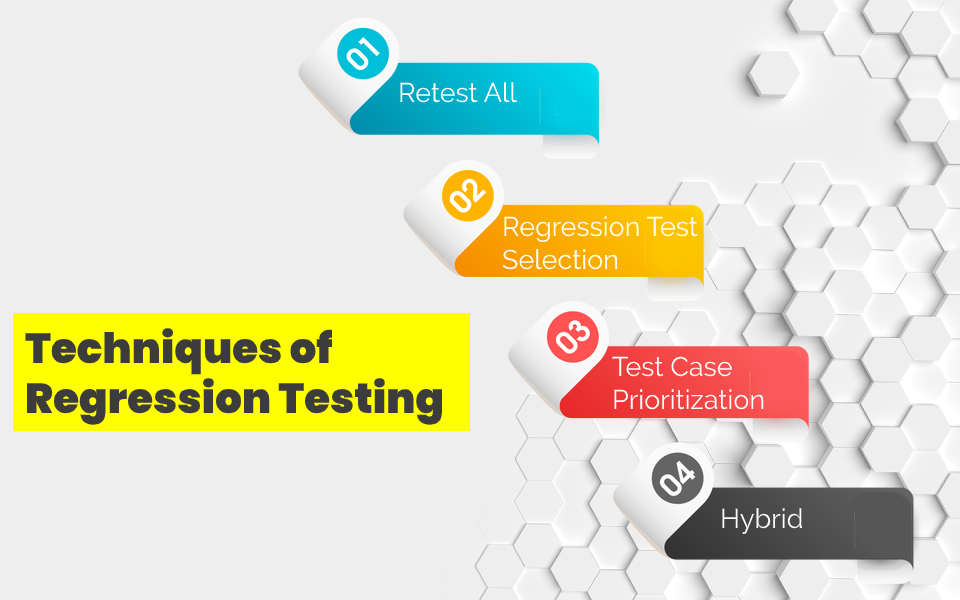9 minutes to read
What is Regression Testing? How to Get Started and What Tools to Use


Ievgen Ievdokymov
Senior QA Engineer
A bug-free, high-performance, and user-friendly product is a goal on which the whole product team works. Regression testing, in its turn, makes a significant contribution to the development of such high-quality products. But what is behind this term? Let's find it out.
What is regression testing?
There are varied types of software testing. However, regression testing stands out from them due to being extremely comprehensive and helpful.
Regression testing is a type of software testing that checks whether recent code changes have affected earlier developed functionality. In the course of regression testing, previously successfully passed test cases are rerun to check key functionality and ensure the correct work of the whole product after software modification.
Importance of Regression Testing
There is no need to explain why new functionalities should be checked. But what about previously developed ones? Why does regression testing focus on this? The reason is that there can be a strong dependency between any software modification and the earlier developed features. Even a minor tweak can considerably affect software performance and behavior, resulting in critical defects. Regression testing tends to cover as many test cases as possible, eliminates all possible risks, identifies system weaknesses, and uncover possible defects. It serves as a filter that catches bugs related to the recent modifications. Besides, regression testing, especially automated, helps developers quickly get feedback on product performance after new code deployment. Therefore, if certain defects are uncovered, it is much easier to understand their root causes and fix them fast.
Besides, regression testing can also uncover old bugs reproduced again due to improper control of software versions.
Generally, regression testing is a compulsory practice in any QA process as it reassures proper product quality. If regression testing is neglected or conducted improperly, there is a high risk of end-user' disappointment due to numerous post-release bugs.
The process of regression testing
Regression testing is conducted at all testing levels whenever software undergoes any modifications and before an upcoming release. So which changes can have a significant impact on the earlier developed software parts? These are:
As a rule, the following plan of regression testing execution is used to get the maximum results:
Techniques of regression testing

As an app is built, it becomes more difficult, time-consuming, and expensive to check all available test cases. Several techniques have been developed to help sort out the most appropriate test cases for regression testing. Depending on particular conditions, QA experts can use a certain technique to get a maximal result at a minimum expenditure of effort.
According to this technique, all available test cases must be rerun to inspect the whole software as thoroughly as possible. Such comprehensive testing is time-incentive and expensive. That is why it is better to use it only if numerous software modules undergo significant changes.
Utilizing this technique, QA engineers run not all but just certain test cases that are picked up on the ground of the preliminary analysis, i.e., only those test cases must be rerun, which cover modified or probably affected modules.
This technique defines the sequence of test cases. Primarily test cases with high priority must be rerun, and then others in descending order. In such a way, critical defects are uncovered as early as possible.
The hybrid technique combines the concepts of the two previous ones. According to it, particular test cases are picked up on the ground of their priority.
Types of regression testing
Various types of regression testing can be applied depending on a testing level, project requirements, goals, nature of modifications, available resources, and deadlines,
This type of regression testing is associated with unit testing. Developers rerun unit tests checking every code unit paying no regard to dependencies between them.
This type of regression testing is performed by virtue of the available test cases while a product remains unchanged. Thus, QA engineers may study a project for effective planning of future activities.
This regression testing examines software from top to bottom and includes all available test cases without exception. It requires a ton of time. As a rule, customers avoid it because of its costliness. Still, sometimes, it is helpful and necessary.
This type of regressive testing helps considerably reduce time and effort as only those test cases are rerun that cover modified or probably affected modules.
This regression testing is conducted when there are changes in project specifications, and new test cases are drawn up to cover them. It enables QA specialists to dive into new version testing, keeping away from earlier tested functionality.
This regression testing is used when there are numerous changes, especially those that can significantly impact the root code.
This testing is used when a new code is added to the codebase. Its main goal is to ensure proper software performance after new code addition.
Regression testing vs. retesting
Regression testing and retesting are often misused and misunderstood by QA novices. On the one hand, both of them are associated with test re-execution. Still, on the other hand, they have different aims and are conducted under different conditions.
Retesting is conducted to verify whether a failed test is passed successfully after debugging or double-check a certain test case if there is any need.
In its turn, regression testing ensures that the whole system works appropriately after any code modifications, which may disrupt the earlier developed functionality.
While retesting focuses on the failed test cases and defect verification, regression testing deals with the previously passed test cases. Besides, due to the labor intensity, time-consuming, and repetitive nature of regression testing, automation is its distinctive feature.
Automated regression testing

While a human tester carries out manual regression testing, the pre-written scripts help commit automated regression testing with little or no QA engineer supervision.
Either manual or automated testing has advantages and disadvantages. However, these days QA experts tend to automate regression testing. Automated regression testing significantly hastens QA procedure, helps avoid human errors, and cuts down expenses related to staff expansion.
The most suitable automation solution must be used, and the appropriate scenarios must be automated to reap the benefits of automated regression testing. Besides, it is essential to draw up sufficient test cases, create effective test data, and continuously update scripts.
The major advantage of automated regression testing is its convenience that is explained by the following things:
So, test automation has multiple pros. Nevertheless, automated testing cannot completely replace manual testing, as there are still plenty of scenarios that cannot be executed by scripts. For this reason, QA experts use both approaches to achieve maximum efficiency.
Challenges of manual regression testing
Over the years, regression testing has been carried out manually. Actually, it is still effective when it comes to small-scale projects. However, dealing with large projects, manual QA engineers face challenges over time. As software evolves, it piles up with tons of features and functions. Consequently, the number of test cases is continuously enhancing. At a certain point in time, there may be not enough resources to run regression testing effectively and on schedule. Consequently, the main challenges associated with manual regression testing are:
In extremely large and sophisticated projects, manual regression testing takes tons of time.
The number of manual QA engineers should be continuously enhanced in order to meet deadlines.
Continuous staff expansion results in the heavy labor expenses.
There is a high risk of human errors, as regression testing is fairly monotonous.
The advantages of regression testing in Agile
Nowadays, most development teams use Agile methodology due to its flexibility and speed. However, the fast development process should not result in a lower quality level. That is where regression testing is extremely helpful, as it is carried out in each iteration known as a sprint during which a particular software part is built.
Merits of regression testing in Agile are apparent, and the main among them are:
Regression testing tools list

Nowadays, there are numerous test automation tools that help QA experts accelerate a QA procedure and offer the best opportunities for optimization of regression testing.
Each QA engineer composes his tech stack according to his own preferences and project requirements. However, below you can find a list of the most convenient and helpful regression testing tools:
Conclusion
It is indeed impossible to overestimate the importance of regression testing. It helps provide high quality, reassuring that any changes, either tweak or substantial, have not harmed earlier developed functionality. Due to the repetitive nature of regression testing and the constantly increasing number of test cases, it makes sense to automate it. In fact, automated regression testing has already proven itself as fast, convenient, and cost-effective. Properly maintained, it can significantly optimize a QA procedure and improve the quality of large-scale projects. The main thing is to choose the right tool and strategy.
